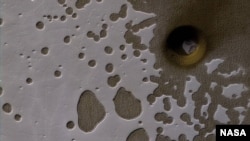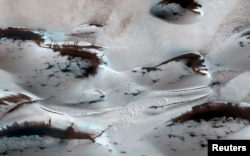A massive and deep circular pit on Mars has NASA officials stumped.
The image of the hole on the Martian surface was taken by the agency’s Mars Reconnaissance Orbiter (MRO) as it scanned the planet’s south pole region.
The hole, which is surrounded by a “Swiss cheese terrain” of frozen carbon dioxide, is likely hundreds of meters across and quite deep.
The image also captures a glimmer of light coming from the bottom of the hole, likely a reflection of the Sun off the ice.
According to Science Alert, there are several possible ways the hole formed, including a meteorite impact, collapsing lava tubes, floods or some kind of volcanic activity.
The “Swiss cheese terrain” is believed to be caused by the sublimation, going directly from solid to gas, of the frozen carbon dioxide.
The image was snapped with the MRO’s “High Resolution Imaging Science Experiment," which allows NASA to see objects on the Martian surface that are larger than one meter from between 200 and 400 kilometers above the Red Planet.
MRO has been circling Mars since 2006 and has captured many interesting images, including dust devils and moving sand dunes.










